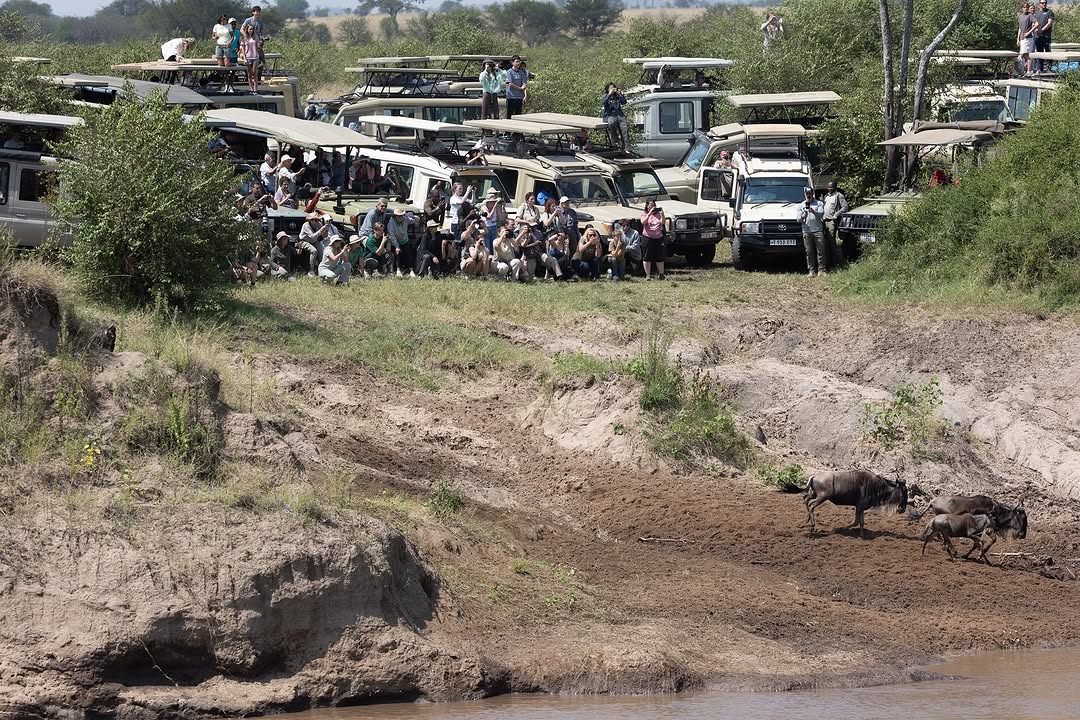
Human Disruption in the Serengeti: A Threat to the Great Wildebeest Migration
The Great Wildebeest Migration: A Natural Wonder Under Threat
The Great Wildebeest Migration is one of the most breathtaking wildlife spectacles on Earth. Each year, over 1.5 million wildebeest, accompanied by hundreds of thousands of zebras and gazelles, journey across the Serengeti in Tanzania to the Masai Mara in Kenya in search of greener pastures. A pivotal moment in this cycle is the dramatic crossing of the Mara River, a scene that captures the raw essence of nature and survival.
However, a recent viral video has brought to light a disturbing case of human interference that disrupted this natural event, sparking global concern among conservationists and nature lovers alike.
A Shocking Incident Captured on Camera
The incident was filmed by safari guide Nick Kleer, who witnessed firsthand the chaos caused by irresponsible tourist behavior. His footage revealed multiple safari vehicles stationed directly in the wildebeest's path, obstructing their access to the river and altering the natural course of their migration.
These vehicles didn’t just block the route—they forced panicked animals to retreat or make dangerous leaps from cliffs in search of escape, risking serious injury or death.
Human Interference: A Growing Conservation Crisis
This situation is not an isolated case. As tourism in East Africa continues to grow, so does the pressure on ecosystems and migratory species. In this particular incident, Kleer expressed his frustration at the lack of control, stating that not only were rangers and guides failing to stop the disruption, some were actively encouraging it to please tourists eager for close-up encounters.
This level of intrusion highlights a disturbing lack of enforcement of ethical wildlife viewing standards, which exist to protect the animals and preserve the natural integrity of their behaviors.
Wildlife in Distress: The Real Consequences
The video clearly shows distressed wildebeest, with many exhibiting signs of panic. Some were injured during the chaos, and others likely perished either from falls or from being separated from the herd.
Unlike the natural dangers faced during the river crossings—such as crocodile attacks or strong currents—this interference was entirely man-made and avoidable. As Kleer noted, “This was not nature being brutal. This was people being careless.”
Ethical Wildlife Tourism: A Call to Action
The reaction from the global conservation community has been swift and vocal. There is a growing consensus that strict regulations and tourism management reforms are needed to ensure such incidents do not happen again.
Key recommendations include:
- Limiting the number of vehicles near crossing points
- Enforcing designated viewing zones
- Providing better training for guides and rangers
- Implementing real-time monitoring of tourist behavior
Without these measures, the very event that draws visitors from around the world—the Wildebeest Migration—may be compromised by the very people who seek to witness it.
The Role of Conservation and Responsible Travel
Safeguarding the Great Wildebeest Migration is not just about protecting animals—it’s about preserving biodiversity, ecosystem balance, and cultural heritage. Tour operators, safari lodges, and tourists all have a shared responsibility to uphold the principles of sustainable and ethical tourism.
Travelers can contribute by:
- Choosing operators certified by eco-tourism and conservation bodies
- Avoiding practices that put animals at risk for the sake of a photo
- Supporting local communities that prioritize wildlife protection
The Great Wildebeest Migration: A Global Treasure Worth Protecting
Spanning nearly 1,800 miles, the Great Migration is a continuous cycle driven by rainfall patterns and the search for food. It is both a triumph of instinct and a fragile ecological event vulnerable to disruption.
The recent incident in the Serengeti should serve as a wake-up call. Without immediate action, we risk turning one of the planet’s most powerful examples of natural movement into a staged spectacle marred by human greed and negligence.
Conclusion: Let Nature Lead
The Serengeti and its iconic migration belong to nature—not to tourists. As guardians of this planet, it is our duty to observe with respect, to travel with integrity, and to ensure that our desire for adventure never comes at the expense of the wild.
Responsible tourism is not a luxury—it’s a necessity. If we want future generations to witness the awe of the Mara River crossing, we must act now to protect it from the growing footprint of human interference.